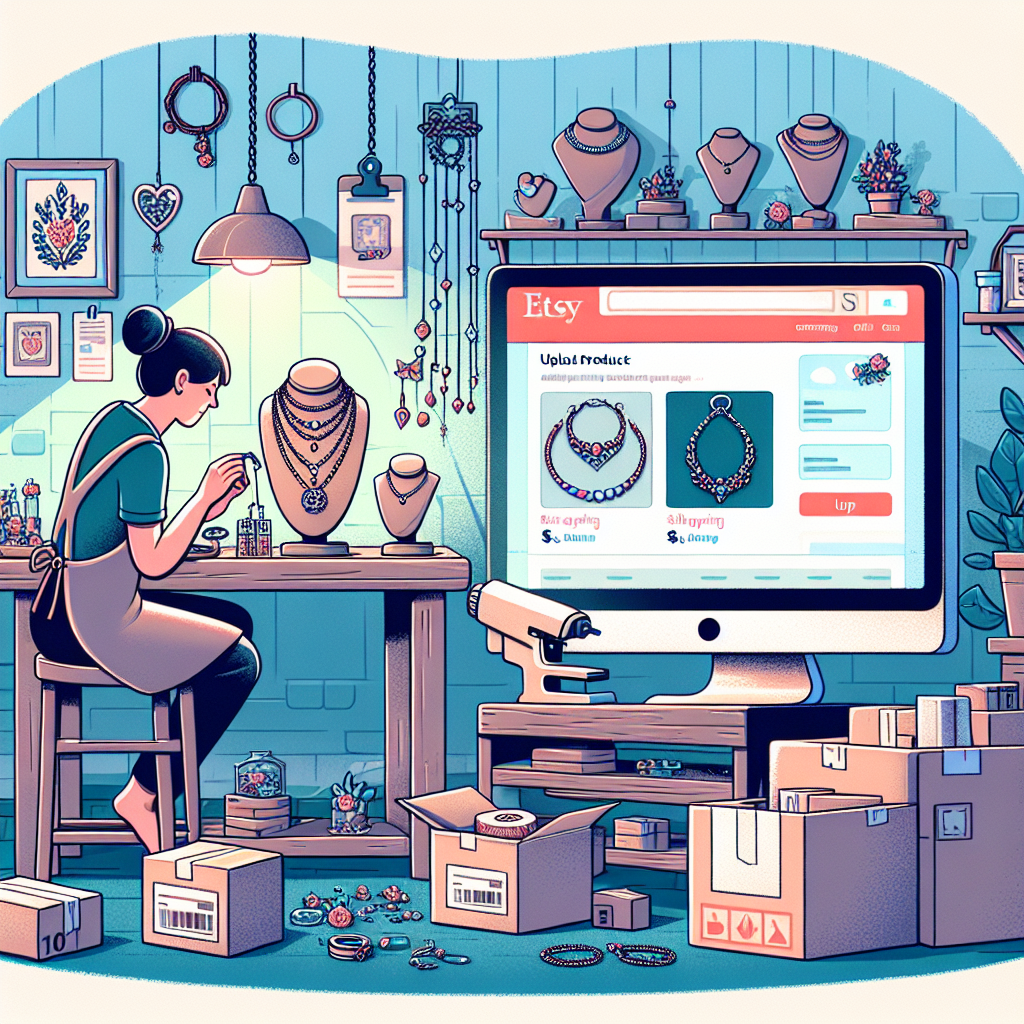How To Sell on Etsy
Selling on Etsy can turn your creativity into dependable income—if you treat it like a business from day one. Follow these numbered steps to go from idea to your first and next 100 sales.
1) Pick a profitable niche and validate demand
– Brainstorm what you can make or source: handmade goods, vintage (20+ years old), or craft supplies.
– Validate demand:
– Type seed ideas into Etsy’s search bar and note autocomplete phrases. Those are high-intent keywords.
– Open the top listings. Check number of reviews, price points, and whether the market skews saturated or underserved.
– Use tools like eRank or Marmalead (or free Google Trends) to assess search volume and seasonality.
– Look for differentiation angles: personalization, material upgrades, sizing options, bundles, faster processing, eco packaging, or gift-ready presentation.
– Set a test scope: plan 10–20 initial products or variations to gauge traction without overcommitting.
2) Confirm you meet Etsy’s rules
– Handmade means made or designed by you. If a production partner helps (e.g., a print shop), disclose them in your listing.
– Vintage must be 20+ years old; be prepared to substantiate age.
– Supplies are tools, materials, or ingredients used to make things.
– Avoid prohibited items (dangerous goods, regulated items) and intellectual property violations. Do not use trademarked phrases in titles/tags unless licensed.
3) Set up your business basics
– Choose a structure (sole proprietor, LLC, etc.) and register as required in your location.
– Get any needed sales tax permits; understand how Etsy handles tax collection in your region.
– Open a dedicated business bank account to separate finances.
– Create a simple cost-tracking spreadsheet to log materials, labor time, packaging, shipping, and fees from day one.
4) Build a brand buyers remember
– Choose a shop name that’s easy to spell, not trademarked, and future-proof if you expand.
– Create a simple logo and banner using a tool like Canva; pick a color palette and font pair that matches your product vibe.
– Draft a one-paragraph brand story: who you are, why you make these products, and what makes them different.
– Decide your photography style (light/airy, rustic, bold color) and stick to it for consistency.
5) Standardize your products for repeatability
– Document materials, tools, and steps for each product.
– Create SKUs that encode product type, color, and size (e.g., MUG-12OZ-WHT).
– Establish processing times you can consistently meet, even during busy seasons.
– Test packaging for protection and unboxing experience; note exact dimensions and weight for accurate shipping.
6) Create your Etsy shop
– Sign up or log in to Etsy, enable two-factor authentication, and click “Sell on Etsy.”
– Set shop preferences (language, country, currency) and pick your shop name.
– Add at least 10 listings to start; fuller shops tend to convert better.
– Complete the About section with photos or a short video of your process.
– Disclose any production partners and fill in Shop Policies (returns, exchanges, shipping, personalization).
– Set up Etsy Payments, add your bank info, and configure tax settings as prompted.
7) Do keyword research and plan your SEO
– Make a list of 10–15 keyword phrases per product: long-tail phrases like “custom birth flower necklace” instead of just “necklace.”
– Group keywords by intent (gift, decor, personalization, style, material).
– Prioritize phrases that match your exact product and have clear buyer intent.
– Create a title blueprint: lead with the strongest phrase, then include 2–3 supporting phrases that don’t feel spammy.
8) Create standout photos and a short video

– Use bright, indirect natural light near a window. Turn off overheads to avoid color casts.
– Shoot on a clean, consistent background. Include:
– One hero image showing the whole product crisply.
– Close-ups of texture or details.
– Scale references (in hand, next to a common object).
– Style/lifestyle shots showing use or fit.
– Variations (colors, sizes) all shown clearly.
– Frame square and aim for at least 2000 x 2000 px. Use all 10 image slots.
– Record a 5–15 second silent clip rotating or using the product to boost engagement.
– Edit lightly to true-to-life color; avoid heavy filters.
9) Write descriptions that convert
– Open with a two-sentence hook explaining what it is, who it’s for, and the main benefit.
– Add a concise specs section:
– Dimensions, materials, color options.
– What’s included (and what isn’t).
– Care instructions and safety notes.
– Processing time and estimated delivery window.
– Explain personalization in a clear checklist format and how to submit details.
– Add use cases and gifting occasions.
– End with a simple call to action: “Choose your size and color, add personalization, and click Add to cart.”
– Put the most important info in the first 155 characters (this often shows in search snippets).
10) Optimize titles, tags, and attributes
– Title: lead with your top keyword phrase, then add 2–4 supporting phrases separated by commas or dashes in natural language.
– Tags: use all 13. Include your exact phrases, synonyms, and long-tail variations. Don’t repeat the same words excessively; cover breadth.
– Categories and attributes: select the most specific category and fill every relevant attribute (color, material, style, holiday, recipient).
– Materials: list key components; shoppers filter by material for many categories.
– After 2–4 weeks, check Shop Stats’ search terms and refine titles/tags to match terms that convert.
11) Price for profit, not just sales
– Calculate your base cost: materials + packaging + average labor time x your hourly rate + overhead allocation.
– Add platform costs: listing fee ($0.20 per listing), transaction fee (commonly around 6.5% of item price plus shipping), payment processing fee (varies by country), currency conversion if applicable, plus any ad spend.
– Choose a margin target that supports growth (often 3x materials cost or 50–70% gross margin, depending on category).
– Consider shipping strategy: build some or all shipping into price to offer free shipping thresholds if that helps conversion.
– Create bundles or sets to lift average order value without proportional increases in labor time.
12) Set up shipping that inspires confidence
– Weigh and measure every product with packaging. Save these in shipping profiles for speed and accuracy.
– Offer tracking on most orders; buyers trust it and Etsy may prioritize tracked listings.
– Choose carriers by item type: fragile ceramics may need extra padding and reliable carriers; lightweight prints can go in rigid mailers.
– Set processing times you can exceed, not just meet. Ship early when possible.
– For international: complete customs forms inside Etsy labels, add HS codes, and state realistic delivery windows. Be clear about duties/taxes being buyer’s responsibility unless you choose Delivered Duty Paid.
– Create a simple unboxing: branded sticker, thank-you card, and care card. Avoid adding heavy freebies that increase postage costs.
13) Write clear shop policies and FAQs
– Returns and exchanges: specify time windows, condition requirements, and exceptions for personalized items where applicable.

– Damage procedure: ask for photos within a set window and clarify whether you’ll replace or refund.
– Processing and shipping times: list ranges and holiday cutoffs.
– Personalization: exact format buyers should provide and what happens if info is missing.
– Care, safety, and age recommendations when relevant.
– Gift wrap and gift message options.
14) Launch with momentum
– Aim to list 20–40 items or variations so you appear in more searches.
– Turn on a small, time-bound shop sale (10–15% for a week) to encourage early conversions.
– Share your launch with friends, family, and relevant communities; ask for favorites and shares, not reviews unless they purchase.
– Post 5–10 pins on Pinterest linking to your top listings; add your shop link to your social bios.
– Enable back-in-stock requests on popular variations so you can capture demand.
15) Deliver five-star service and earn reviews
– Send a warm order confirmation message summarizing the order, personalization, and estimated ship-by date.
– Ship on or ahead of schedule. Upload tracking promptly.
– Include a friendly insert thanking the buyer and offering care tips. Do not offer incentives for reviews; simply mention Etsy will ask for one.
– If issues arise, respond within 24 hours with a solution path (replacement, partial refund, troubleshooting).
– Aim for Star Seller metrics by replying quickly, maintaining high ratings, and shipping on time.
16) Promote smartly on and off Etsy
– Etsy Ads: start with a small daily budget focused on a few proven listings. Pause ads on items with low click-through or poor conversion after enough data.
– Sales and coupons: use abandoned cart and thank-you coupons to encourage repeat purchases.
– Content: post short making-of videos, before/after photos, and gift guides on Instagram, TikTok, and Pinterest. Link to specific listings, not just your shop home.
– Collaborations: partner with complementary Etsy shops for bundle promotions or with micro-influencers for authentic content.
– Email list: include a QR or link in your insert to a simple sign-up for care guides or size charts. Email new product drops and seasonal deadlines.
17) Analyze and iterate every month
– Check Shop Stats:
– Conversion rate (2–3% is a common baseline; varies by category).
– Top search terms and traffic sources.
– Listings with high views but low conversion—fix photos, pricing, or descriptions.
– Listings with high conversion—clone the formula and expand variations.
– Refresh underperforming first photos, update titles/tags to match converting terms, and test new price points.
– Add seasonal products 6–8 weeks before demand peaks; archive true non-performers after testing.
18) Systemize and scale
– Create templates for customer messages, listing descriptions, and photo setups to save time.
– Batch production and packaging; reorder materials at predetermined stock levels.
– Document standard operating procedures so you can outsource tasks like packing, photo editing, or customer service as you grow.
– Consider production partners or print-on-demand for scalable items, ensuring quality and on-time delivery remain high.
Quick 30-day action plan
– Week 1: Validate niche, name your shop, design brand assets, and standardize 5 core products.
– Week 2: Photograph and write listings; complete shop policies and About section; set up shipping profiles.
– Week 3: Publish 15–25 listings; set a small launch sale; share on socials and Pinterest; turn on modest Etsy Ads for 3–5 listings.
– Week 4: Ship first orders fast; collect feedback; tweak titles/tags; plan 5 additional listings or variations based on early data.
Final tip: Consistency beats intensity. Add new or refreshed listings weekly, respond quickly, and keep refining. Etsy rewards shops that help buyers find exactly what they’re looking for and deliver a great experience—make that your north star.


